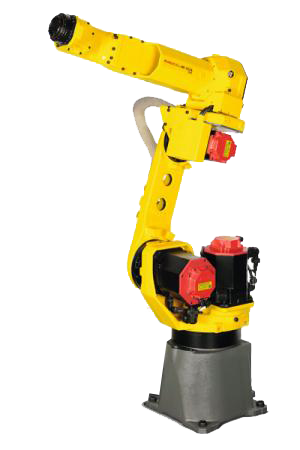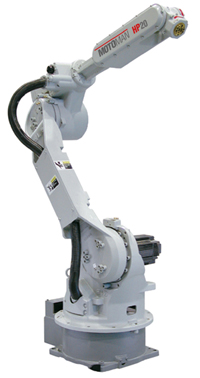Robots Done Right |
Used Robot Sales |

Thermal Spray Robots

Thermal spraying is a coating process involving the spraying of melted or heated materials onto the surface of a workpiece. Coating materials include metals, alloys, ceramics, plastics, and composites. They are often used in powdered or wire form, heated to a molten state, and accelerated toward workpieces as micro particles to coat surfaces. Thermal spray applications are commonly used in industries such as automotive and aerospace, to protect parts from factors consisting of high temperatures, corrosion, erosion, and wear.
In the 1990s manufacturers began to automate their thermal spray applications with industrial robots like the FANUC M-20ia/10L. Inconsistencies in quality and productivity, along with the dangers of manual thermal spraying made manufacturers realize they needed to replace human workers with robots as advances in technology made them a more affordable solution. Six axis robots are generally used for thermal spray applications as they provide three axes for base motions and three axes for applicator orientation. They are able to apply coatings to a number of parts no matter how big or complex they may be as well as reach difficult angles. This allows manufacturers more freedom within their productions as robots are capable of spraying more complicated and intricate parts with greater accuracy and repeatability than with manual coating.
Robots such as the ABB IRB 2400 can be easily programmed to control thermal spray parameters including temperature, coat thickness, and number of passes. Parts are sprayed evenly and consistently every time, increasing quality. With manual spraying it is impossible to control coat thickness or speed and quality greatly relies on the skills of the worker. This results in part inconsistencies as well as potential errors with over and under spray. These errors can be costly to manufacturers as materials are wasted and cycle time increases. Thermal spray robots increase productivity with their control and precision. Parts turn out even and uniform in much shorter timeframes than with manual coating.
Thermal spray robots offer a cost-effective solution to manufacturers looking to meet the high productivity and quality demands of today’s industrial world while also increasing workplace safety. Contact us by email mm@robotsdoneright.com or phone (440) 724-6568 today to discuss buying or selling a thermal spray robot.